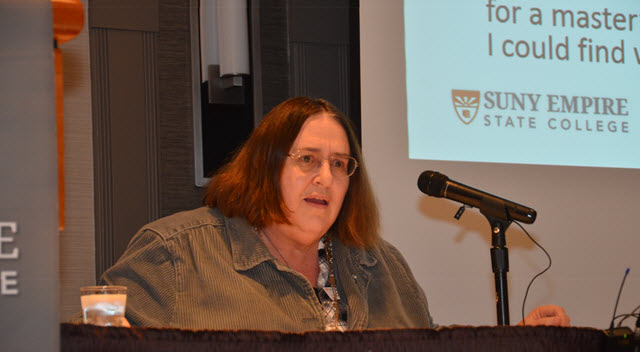This section of the SUNY Empire website is no longer being updated.
View current SUNY Empire Stories.
November 6, 2017
Gayle Stever Delivers Susan H. Turben Faculty Lecture

Thirty years ago, no one was researching fan behavior and “superstar mania” in the field of psychology and lifespan development. When Gayle Stever, associate professor in Social Sciences with the college’s Rochester location, looked at the literature, it was almost all coming from the communication field. Stever saw an opportunity to approach fandom from a human development point of view, and to collaborate with colleagues in the communication field on research about “parasocial relationships,” exemplified by audience members who know the object of their fascination, but whom are not known back. According to the website findapsychologist.org:
Parasocial relationships are one-sided relationships, where one person extends emotional energy, interest and time, and the other party, the persona, is completely unaware of the other’s existence. Parasocial relationships are most common with celebrities, organizations (such as sports teams) or television stars.
Stever is the 2017 recipient of the Empire State College Foundation Susan H. Turben Award for Excellence in Scholarship. She gave the Susan H. Turben Lecture at the Fall Academic Conference, titled, “The Impact of Media: A New Model for Understanding Parasocial Experiences.”
Stever saw an opportunity to conduct rich research in this area via case studies of the fans of Michael Jackson, Bruce Springsteen, Madonna and other fans in the 1980s, Star Trek fans and other science fiction fans, and the fans of the singer Josh Groban. In 1988, she attended her first Michael Jackson concert, to do surveys and interview research with the superstar’s fans. She was surprised to see that Jackson’s fans were not “teeny boppers” but were his age, plus or minus about five years. She wrote her thesis on “this jargony thing they called ‘parasocial relationships’,” she said. She submitted a paper to the APA and in 1994 presented her dissertation research at the national conference. Then again in 2011, she was invited to give an hour-long address on the subject of parasocial theory.
In 2009, Stever joined the college, where she was “really attracted to its interdisciplinary environment,” especially since her research has such an overlap with communication, anthropology and sociology, and where she wouldn’t get “flack for studying celebrity culture, fan culture, which really dominates the scene today.”
She noted that all fans tend to want to meet their favorite celebrity, and attend concerts, conventions and other venues in which they may meet them. She said that it is “a cultural myth that they are impossible to meet. To the contrary, most celebrities, even some of the most high profile, are not that hard to meet, if you travel to events and look for opportunities.”
Older fans, she said, tend to interact with celebrities through such means as joining them in their philanthropic endeavors. Groban’s fans help him to raise money for his charity foundation, Find Your Light, which raises money for arts education. Michaelfest brought together Michael Jackson fans who cycled their adoration into a massive canned-food drive. Star Trek stars each have favorite charities, and their fans will get involved with fundraising in partnership with them.
Stever also talked about personality type and fandom, telling her colleagues that the majority of fans are “normal,” compared to the 20 percent of any population (fan or otherwise) who wrap their lives around the involvement with their favorite celebrity and if that celebrity died, would no longer want to live.
Social media has had an interesting effect on fandom. In addition to conventions, people may gather on dedicated Facebook pages or interact with their celebrity via Twitter, which makes the celebrity even more available for interaction.
“Twitter has meant that fans who couldn’t travel to meet celebrities can interact with them on Twitter. Many big-name celebrities are online interacting with fans. It’s still parasocial; it’s not an equitable relationship,” Stever explained.
A new category brought on by the Internet is microcelebrites – those not otherwise famous people who have amassed huge Internet followings through their blogs, Youtube, Instagram or Facebook and other social media accounts. They are often recruited to be brand ambassadors for various products.
“All of these new roads to celebrity have changed the very nature of both the concept of celebrity and the impact of media,” Stever said.
Stever came to the college eight years ago from Arizona State University Polytechnic Campus, where she was an assistant professor. Her research has broken ground in the area of fan behavior and the growing field of social media research. She has published and presented in numerous peer-reviewed journals and at academic conferences. Her curriculum vita lists 23 articles and 26 conference presentations. On researchgate.com, a social media site for scholars, she has 23 publications available, including 14 articles, three book chapters, and six conference papers. Nearly 11,000 people have read copies of her work on this site.